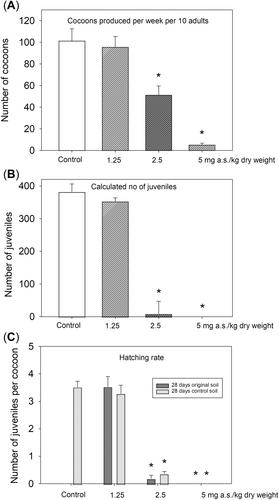下载PDF
{"title":"推进土壤风险评估:新型蚯蚓茧测试与毒代动力学-毒效学模型互补方法。","authors":"Kim Rakel, Vanessa Roeben, Gregor Ernst, Andre Gergs","doi":"10.1002/etc.5976","DOIUrl":null,"url":null,"abstract":"<p>In the current European Union pesticide risk assessment for soil organisms, effect endpoints from laboratory studies (Tier 1) and field studies (higher-tier risk assessment) are compared with predicted environmental concentrations in soil, derived from the proposed use pattern. The simple but conservative initial Tier 1 risk assessment considers a range of worst-case assumptions. In contrast, the higher-tier assessment focuses on specific conditions tested in the corresponding field study. Effect modeling, such as toxicokinetic–toxicodynamic (TKTD) modeling, is considered a promising future tool to address uncertainties in soil risk assessment, such as extrapolation to different ecological, pedo-climatical, or agronomical situations, or to serve as an intermediate tier for potential refinement of the risk assessment. For the implementation of TKTD modeling in soil organism risk assessment, data on earthworm growth and reproduction over time are required, which are not provided by the standard Organisation for Economic Co-operation and Development (OECD) 222 laboratory test. The underlying study with carbendazim presents a new earthworm cocoon test design, based on the OECD 222 test, to provide the necessary data as input for TKTD modeling. This proposed test design involves destructive samplings at days 7, 14, 21, and 28, enabling the determination of growth, cocoon number, and the number of juveniles hatched per cocoon in 7-day intervals. The new cocoon test allowed the disentanglement of the toxic effect of carbendazim in earthworms: At the highest concentration prominent effects on growth and reproductive output were observed, and the number of cocoons was significantly reduced compared to control. The results highlighted different physiological modes of action: effect on growth via higher maintenance costs as a primary mode of action as well as a reduced number of cocoons (effect on reproduction) and a lower number of juveniles hatching from each cocoon (hazard during oogenesis) as a secondary mode of action. We provide an example of how this new test's data can be used to feed a dynamic energy budget theory–TKTD model of <i>Eisenia fetida</i>. We also validate it against the original OECD 222 test design, outlining its potential future use in soil risk assessment. <i>Environ Toxicol Chem</i> 2024;43:2377–2386. © 2024 The Author(s). <i>Environmental Toxicology and Chemistry</i> published by Wiley Periodicals LLC on behalf of SETAC.</p>","PeriodicalId":11793,"journal":{"name":"Environmental Toxicology and Chemistry","volume":"43 11","pages":"2377-2386"},"PeriodicalIF":3.6000,"publicationDate":"2024-08-22","publicationTypes":"Journal Article","fieldsOfStudy":null,"isOpenAccess":false,"openAccessPdf":"https://onlinelibrary.wiley.com/doi/epdf/10.1002/etc.5976","citationCount":"0","resultStr":"{\"title\":\"Advancing Soil Risk Assessment: A Novel Earthworm Cocoon Test with a Complementary Toxicokinetic–Toxicodynamic Modeling Approach\",\"authors\":\"Kim Rakel, Vanessa Roeben, Gregor Ernst, Andre Gergs\",\"doi\":\"10.1002/etc.5976\",\"DOIUrl\":null,\"url\":null,\"abstract\":\"<p>In the current European Union pesticide risk assessment for soil organisms, effect endpoints from laboratory studies (Tier 1) and field studies (higher-tier risk assessment) are compared with predicted environmental concentrations in soil, derived from the proposed use pattern. The simple but conservative initial Tier 1 risk assessment considers a range of worst-case assumptions. In contrast, the higher-tier assessment focuses on specific conditions tested in the corresponding field study. Effect modeling, such as toxicokinetic–toxicodynamic (TKTD) modeling, is considered a promising future tool to address uncertainties in soil risk assessment, such as extrapolation to different ecological, pedo-climatical, or agronomical situations, or to serve as an intermediate tier for potential refinement of the risk assessment. For the implementation of TKTD modeling in soil organism risk assessment, data on earthworm growth and reproduction over time are required, which are not provided by the standard Organisation for Economic Co-operation and Development (OECD) 222 laboratory test. The underlying study with carbendazim presents a new earthworm cocoon test design, based on the OECD 222 test, to provide the necessary data as input for TKTD modeling. This proposed test design involves destructive samplings at days 7, 14, 21, and 28, enabling the determination of growth, cocoon number, and the number of juveniles hatched per cocoon in 7-day intervals. The new cocoon test allowed the disentanglement of the toxic effect of carbendazim in earthworms: At the highest concentration prominent effects on growth and reproductive output were observed, and the number of cocoons was significantly reduced compared to control. The results highlighted different physiological modes of action: effect on growth via higher maintenance costs as a primary mode of action as well as a reduced number of cocoons (effect on reproduction) and a lower number of juveniles hatching from each cocoon (hazard during oogenesis) as a secondary mode of action. We provide an example of how this new test's data can be used to feed a dynamic energy budget theory–TKTD model of <i>Eisenia fetida</i>. We also validate it against the original OECD 222 test design, outlining its potential future use in soil risk assessment. <i>Environ Toxicol Chem</i> 2024;43:2377–2386. © 2024 The Author(s). <i>Environmental Toxicology and Chemistry</i> published by Wiley Periodicals LLC on behalf of SETAC.</p>\",\"PeriodicalId\":11793,\"journal\":{\"name\":\"Environmental Toxicology and Chemistry\",\"volume\":\"43 11\",\"pages\":\"2377-2386\"},\"PeriodicalIF\":3.6000,\"publicationDate\":\"2024-08-22\",\"publicationTypes\":\"Journal Article\",\"fieldsOfStudy\":null,\"isOpenAccess\":false,\"openAccessPdf\":\"https://onlinelibrary.wiley.com/doi/epdf/10.1002/etc.5976\",\"citationCount\":\"0\",\"resultStr\":null,\"platform\":\"Semanticscholar\",\"paperid\":null,\"PeriodicalName\":\"Environmental Toxicology and Chemistry\",\"FirstCategoryId\":\"93\",\"ListUrlMain\":\"https://onlinelibrary.wiley.com/doi/10.1002/etc.5976\",\"RegionNum\":4,\"RegionCategory\":\"环境科学与生态学\",\"ArticlePicture\":[],\"TitleCN\":null,\"AbstractTextCN\":null,\"PMCID\":null,\"EPubDate\":\"\",\"PubModel\":\"\",\"JCR\":\"Q2\",\"JCRName\":\"ENVIRONMENTAL SCIENCES\",\"Score\":null,\"Total\":0}","platform":"Semanticscholar","paperid":null,"PeriodicalName":"Environmental Toxicology and Chemistry","FirstCategoryId":"93","ListUrlMain":"https://onlinelibrary.wiley.com/doi/10.1002/etc.5976","RegionNum":4,"RegionCategory":"环境科学与生态学","ArticlePicture":[],"TitleCN":null,"AbstractTextCN":null,"PMCID":null,"EPubDate":"","PubModel":"","JCR":"Q2","JCRName":"ENVIRONMENTAL SCIENCES","Score":null,"Total":0}
引用次数: 0
引用
批量引用


